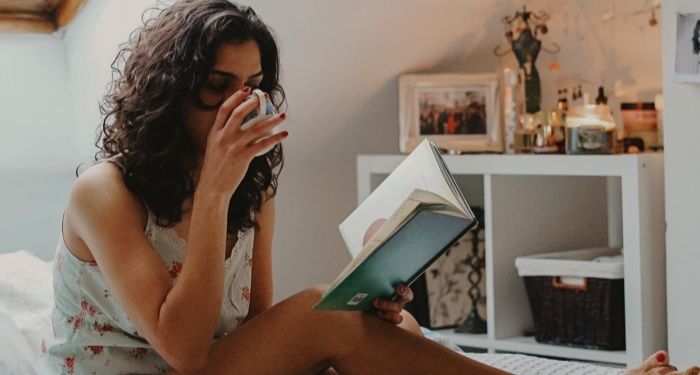
This content contains affiliate links. When you buy through these links, we may earn an affiliate commission.
Literary point of view is the perspective from which an author tells a story. It’s one of the most important decisions authors make in shaping a story. The narrator can be unnamed or a specific character. Authors also choose whether to write in first, second, or third person. Readers can determine this partly by which pronouns refer to each character.
First Person
First-person, limited narration is used in many novels. The narrator is called “I,” and their knowledge of the story is incomplete. Most memoirs are also written in first-person limited (with some exceptions — more on that in a minute). First person provides a sense of the narrator’s voice.
A first-person narrator is often — but not necessarily — the protagonist. Starr Carter in The Hate U Give is a protagonist who is also the first-person narrator. Readers experience the novel’s events alongside her. Nick Carraway is a character and narrator in The Great Gatsby, but not the main character. By not making Jay Gatsby the narrator, the novel depicts his inner circle while preserving his mystique.
First-person omniscient, or all-knowing, narrators are much rarer. The narrator of The Lovely Bones is a murdered child, observing her loved ones from the afterlife.
A first-person plural POV is even rarer. In 2018 on Book Riot, I mentioned The Virgin Suicides and Faulkner’s short story “A Rose for Emily” as examples of this POV. When the POV is “we,” the narrator is a collective, not an individual. In the case of the Faulkner story, the narrative “we” refers to an entire town.
Book Deals Newsletter
Sign up for our Book Deals newsletter and get up to 80% off books you actually want to read.
Thank you for signing up! Keep an eye on your inbox.
By signing up you agree to our terms of use
Second Person
The second person, “you,” has many possible uses in narration. Sometimes the narrator addresses the reader in second person directly, as in Choose Your Own Adventure books. In other examples, readers themselves do not become characters in the story, but the second person allows them to identify more closely with a distinct character.
“Girl” by Jamaica Kincaid is a second-person short story, written in the form of a mother advising her daughter. House of Prayer No. 2 is a rare memoir written in the second person, which immerses the reader into author Mark Richard’s isolating experience of growing up disabled in the 1960s.
Third Person
Third person pronouns include he, she, and they. Third-person limited narration sticks closely to one character’s perspective. The author has a little more flexibility in third than in first person. For example, they can use their adult vocabulary instead of exclusively using words a young protagonist would know.
Third-person omniscient narration is one of the most common POVs in fiction. The narrator knows the entire story and can reveal characters’ thoughts. Third-person narration that observes characters from a distance and incorporates individual characters’ thoughts is called free indirect discourse. Jane Austen was one of the first authors to use this style.
When authors switch perspectives too often, some readers may find this “head-hopping” confusing. Louise Harnby blogged that readers may feel disoriented if they must adjust to a different character’s thoughts from one sentence or paragraph to the next. Today, many authors have multiple POV characters within the same novel, but they may choose to focus on one character’s POV for an entire chapter or section to avoid head-hopping.
Third person is often considered more objective than first or second person, but this is not necessarily true. Also, even an unnamed, third-person, omniscient narrator does not necessarily represent the author’s personal voice or opinions. Roland Barthes wrote about this distinction between authors and their narrators in his essay “The Death of the Author.” As Stacey Megally recently wrote on Book Riot, there’s no such thing as a totally objective or “reliable narrator” because all real and fictional people have biases and imperfect recall and knowledge.
How to Choose the Right POV
All these perspectives have pros and cons. So, how do writers determine which point of view works best for a particular story?
It depends on the author’s goals for their story. A romance writer might want to focus on a first-person protagonist’s uncertainty, surprising the readers and protagonist alike when their attraction is reciprocated. If the same story had an omniscient narrator, or the love interest as another POV character, readers would already know the attraction was mutual. This could either spoil the tension or create more tension through dramatic irony, depending on the author’s approach. This applies to any genre in which suspense is important, including mystery and horror. Deciding the structure of the story and how much information to withhold from readers can also help writers choose the best POV.
First-person POV helps some readers relate more to a character, while other readers prefer the broader vantage point of third person. As a reader, I don’t have a strong preference for a particular POV, but as a fiction writer, I do. So far, all my stories accepted by literary journals have been first person. When I began submitting my work to lit mags in college in 2009, first-person stories seemed more popular. Now, third person seems more popular, at least for literary journals.
Having preferences is inevitable. However, when reviewers call a first-person story “voice-y,” that critique feels vague and dismissive to me, especially if the character or author is marginalized. Voice and character can overwhelm other story elements, like plot, but that’s a more nuanced criticism than “voice-y.” Second-person narration is often experimental and challenging, but I like how it makes me consider characters and stories differently.
